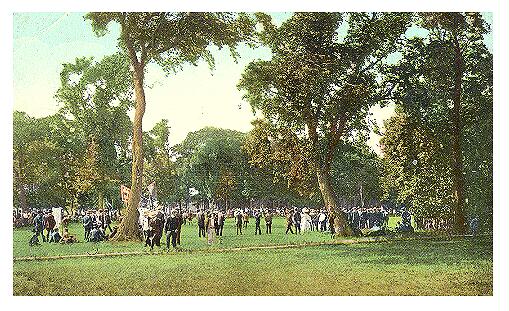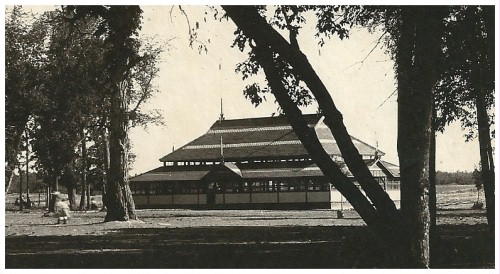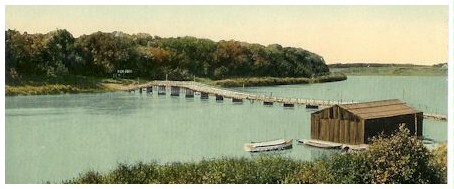
MANITOBA

Winnipeg
NO PART OF THE FOLLOWING
ARTICLE AND PHOTOGRAPHS
MAY BE REPRODUCED WITHOUT
PERMISSION FROM THE AUTHOR ©
This was a trolley park begun next to the east side of The Red River by Albert William Austin's Winnipeg Street Railway Company -- later sold to The Winnipeg Electric Street Railway Company, which after 1924, became The "Winnipeg Electric Company". It was mainly a picnic ground but did incorporate some amusements. The transportation company used the area to garner business during off-peak times by providing a place to go (using a streetcar, of course) on days and evenings off.
The streetcars stopped at the entrance to River Park, also owned by Albert Austin. One then walked to the shore and stepped out on to a pontoon bridge, apparently built at Austin's expense. There, one paid admisison and crossed the river into Elm Park.
This bridge had a hump near the Elm Park side that allowed boats to go under it. Whenever a larger boat came along, a section of the bridge had to be removed in order for the ship to pass. (See farther along for bridge photos.)
This park's name came from the huge elms, ash and cottonwood trees on the property which provided a closed canopy -- a very shady place. This virtue was often referred to in newspaper articles with such phrases as "picnic under the elms".
|
Elm Park Circa 19-0s 
|
One of the first structures there was a covered, open-air pavilion built in 1890. It's unknown as to what activities were held there, but dancing would not have been out of the question. In fact, a photo farther on shows a sign advertising the same at the bridge entrance to the park.
|
Pavilion Date Unknown 
|
The only amusements appear to have been swings and a carousel. The latter ride was housed under a round canvas tent, likely meaning a portable unit. It was apparently there for at least the park's first season, but at some point may have been moved to River Park. A photo taken in that park in 1900 shows what appears to be the same unit. Considering both parks had the same owner (and by 1906 if not before, the same manager, Thomas Morris), it wouldn't be unusual for them to move the ride. On the other hand, there may possibly have been two of the same model, with one at each park. Considering the fact that Elm was mainly a picnic park in a natural setting, while River was more of an amusement park, a move seems likely.
|
Elm Park Picnic Area Circa 1890s 
|
|
Elm Park Walkway Circa 1890s  The walkway is bordered by the Red River. |
|
Elm Park Walkway Circa 1890s  This walkway has a fence and so may have been taken later in time from the above photo. |
The Bridge
A pontoon structure crossed The Red River at the park's location. The photo below, taken around the turn of the century from across the river, shows two concessions. They are barely visible, one each on either side of the bridge. Signs at a food concession on the right side read: "J. Fine Candies"; "Have Sweetness Skinned a Mile"; "Our Fresh Roasted and Salted PNUTS"; "Food Lovers and all Other Lovers Eat Here. If You Try us, You Will Quit the Other Fellow". On the bridge itself, another sign displays "Ice Cold Coca Cola (in its trademarked script) Sold Here".
The concession to the left side of the bridge is less visible. There is a large `P' on one side of its roof. In other photos there is a crude, wooden platform -- perhaps a bandstand or perfromers' stage? Visible in a couple of the Elm Park images, there are rustic, wood-branch park benches with backs.
|
Elm Park Pontoon Bridge Circa 1890s or 19-0s  This is taken from the River Park side of the Red River. Might the building in the foreground be for boat rentals? |
|
Elm Park Pontoon Bridge Circa 1890s  Tickets were 5 cents. A sign advertises dancing. |
|
Elm Park Pontoon Bridge Circa 1890s  Here, a section of the bridge has been floated out of the way to allow a steamer to pass. |
Elm Park lasted until 1911 or 12 when it was determined that a better span was needed to cross The Red River at this point. Elm Park Realty Company built The Elm Park Bridge, an iron span. Although closed in 1965 in favour of The St. Vital Bridge, it still exists today as a pedestrian crossing.
It is assumed that the reality company either bought the land on either side of the bridge from The Austin Rail Line or was a subsidiary of the rail company itself. They wished to erect residences on Elm Park's land.
Work on the residential development began probably a little before the 1912 bridge was completed. The housing development retained the name "Elm Park" and was fully realised over the succeeding years, obliterating any traces of the former pleasure area. The real estate company left one or two postage-stamp parks under names other than "Elm" amongst the houses as open recreational areas.
Today the residential area has an ice cream parlour at the foot of the old Elm Park Bridge. A recent undertaking called The "Churchill Parkway" is one of six local trailways projects. It is expected to provide a link on the west side of The Red River from Don Gerrie Park to the Elm Park Bridge. It will consist of a pathway, signage and amenities.
(See River Park which was also owned by Austin.)
|
Thanks to Vere Scott of Winnipeg, Manitoba for major material
on this park and for providing information on the Austin Rail Line.
Appreciation goes to Rob McInnes of Winnipeg for submissions of postcard scans showing the walkways, picnic area, the bridge and the pavilion. |
Return to the
Closed Canadian Parks Index
